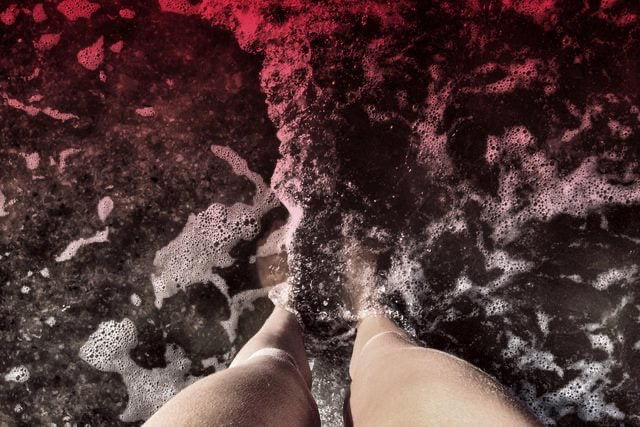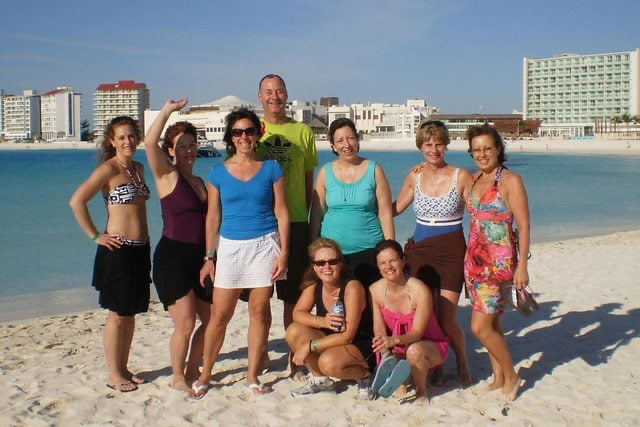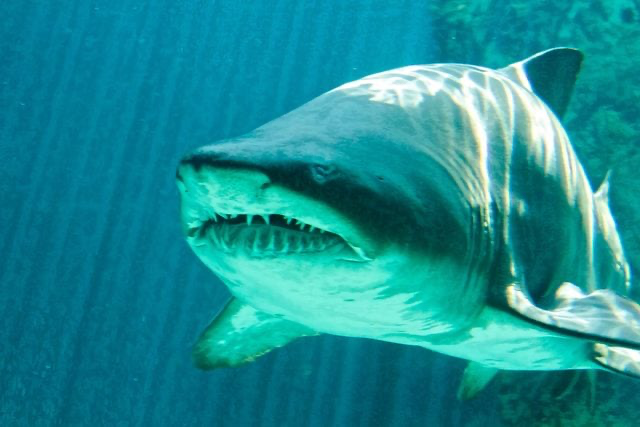While on vacation in Cancún, Nicole Moore decided to take a swim after a beach volleyball match. Unbeknownst to her, this brief swim would attract dangerous attention, leading to an intense medical battle for her survival.

On the last day of January in 2011, Nicole Moore was wading in the waters off a Cancún beach, waist-deep. The 39-year-old nurse from Orangeville, Ontario, north of Toronto, was enjoying the final moments of her vacation with friends from her fitness group.
At that moment, Nicole was alone. She had just finished a game of beach volleyball, and while the rest of the group returned to the hotel for lunch, she lingered in the warm sea to rinse off the sand from her energetic dives during the game. Unbeknownst to her, these seemingly harmless movements were creating ripples in the ocean.
Looking up, Nicole noticed two people on Jet Skis, gesturing and shouting to her in Spanish. Misinterpreting their signals as playful, she waved and laughed, unaware of their true intent.

Unaware of the danger, Nicole didn’t realize the Jet Skiers were urgently signaling her to exit the water. They had spotted two bull sharks and were trying to drive them away. While one shark retreated into the depths, the other lingered, menacingly approaching the shore.
It was only after the Jet Skiers’ frantic shouts that Nicole sensed peril.
Turning towards the land, Nicole started to make her way out of the water when she felt an unexpected nudge. Confusion turned to horr*r as a shark clamped onto her left thigh, its serrated teeth sl!cing through skin and muscle to the bone, stripping over a foot of tissue from her leg. The sea around her erupted in a cloud of crimson.
Despite the absence of pain, Nicole’s instincts screamed danger. She had to escape the water. But her left leg, r@vaged by the shark, refused to respond. Desperately, she began swimming towards the beach using her arms.
The shark, however, wasn’t finished. It encircled her before att@cking again, seizing her left arm in its powerful jaws.
Nicole’s scream pierced the air, “No!”
Her entire arm was trapped in the shark’s mouth as it began dr@gging her down into the depths.
A terrifying thought crossed her mind: Would this be her end? Would her children lose their mother in such a gru*some manner?
Summoning every ounce of her remaining strength, Nicole raised her right fist and struck the shark’s nose.
The impact forced the shark to release its grip, and it disappeared into the sea.
Left amidst the blood-sta!ned waters, Nicole battled shock and the threat of losing consciousness. Her left arm dangled, barely attached, and her left leg was immobile.
As Nicole teetered on the brink of being submerged, one of the Jet Skiers sped in her direction. Extending his hand, he clasped Nicole’s right hand firmly. With a surge of power, the Jet Skier whisked her towards the beach, her blood mingling with the ocean’s blue as they moved.

The Jet Skier swiftly beached his craft, leapt off, and hauled Nicole onto the shore. A bilingual crowd quickly gathered, chattering in both Spanish and English. Despite being conscious, Nicole instinctively assessed her own injuries. She pressed against the sand, managing to lift her head and shoulders just enough to survey the damage to her leg and arm. “Help me,” she uttered weakly before her head dropped back down. Overwhelmed by fatigue, she fought the urge to succumb to sleep, which could mean never waking up again.
“Talk… to… me!” she implored with diminishing strength, pleading to be kept conscious.
The blood loss made breathing a laborious task. Her heart struggled to deliver enough blood to her lungs, threatening respiratory failure due to inadequate oxygen exchange. With each heartbeat, a fountain of blood spurted from her leg, shooting up a foot into the air.
A bystander, an American, knelt beside her and wrapped his hands around her leg, applying pressure to the artery to stem the bleeding.
“My arm…” Nicole managed to say, indicating the need for a tourniquet.
Two nurses from the crowd called out for a string. A man quickly obliged, removing the drawstring from his shorts to provide for the makeshift tourniquet, which one of the nurses fashioned around Nicole’s mangled arm.
A murmur from the crowd, “She won’t make it. Such blood loss isn’t survivable,” hung in the air, but the nurses persisted in engaging Nicole, striving to keep her alert.
For Nicole, moments stretched into eternity. Her thoughts wandered to her two daughters. The prospect of never again seeing her children, her spouse, her father weighed heavily on her. A radiant, encompassing light appeared before her eyes. Resigned, she prepared herself for the end, lying amidst the sand, drenched in sweat and blood.
Suddenly, the sound of a siren cut through the haze.
By the time the paramedics navigated Nicole into the emergency room, her body was on the brink of collapse, her consciousness had slipped away, and her breathing had ceased. The emergency team sprang into action, battling time to save her life. In a grueling eight-hour surgery, they placed a central line directly into her heart, infusing countless units of blood and plasma to sustain her cardiac function.
Upon awakening, Nicole found herself in a hospital bed, connected to a ventilator with a tube inserted through her throat. She would later discover that the piece of her thigh that the shark had torn away was retrieved by her friends on the beach and brought to the hospital, where it was reattached to her leg without connecting it to a blood-supplying vein, indicating its eventual necrosis. Additionally, her arm was severely damaged, and by the second day, her hand started showing signs of necrosis.
Nicole’s condition was grave: toxins from the trauma flooded her system, she was dehydrated, plagued by a severe headache, and felt overwhelmingly heavy, lethargic, and exhausted. The pain was intense, yet she was alive, and the removal of the breathing tube was imminent.
After the incident, a friend had promptly informed her husband, Jay, and her father, Alberto, back in Toronto, who had since made their way to her side. As Jay walked into her room, he struggled to hold back his emotions. In an attempt to bring some lightness to the grim situation, he conceded to Nicole’s longstanding request for a puppy for their daughters, saying, “OK, you can have your dog!”
In the perilous days following her attack, on February 5, Nicole was airlifted back to Toronto via a medical jet, orchestrated by her husband Jay. There, she was under the care of Dr. Laura Snell, an esteemed plastic and reconstructive surgery specialist, and Dr. Andrew Fagan, who took a particular interest in Nicole’s case, expressing astonishment at the shark’s teeth imprints on her bones.
Upon unwrapping Nicole’s bandages, the doctors were confronted with the sight of decay, seawater, and sand within the dressings, and the stench of infection was potent. The doctors were taken aback by the necrotic state of the tissue flap on Nicole’s leg, which lacked any blood flow. The prognosis for her arm, signaled by her discolored fingers, was grim.
In surgery, Drs. Snell and Fagan meticulously debrided Nicole’s wounds, excising all necrotic, damaged, and infected tissue. They were dismayed to find no viable blood supply beyond the primary site of injury on her arm. The medical team removed the necrotic flap from Nicole’s leg, replacing it with a fresh dressing, and Dr. Snell eased the sutures on Nicole’s arm to alleviate pressure from the dead tissue. Copious amounts of saline were used to cleanse the wounds of sand and debris.
Despite her critical condition, Nicole’s resilience was remarkable. Dr. Snell was taken aback when Nicole managed to sit up and converse shortly after surgery. Even more striking was Nicole’s unwavering optimism; she faced each setback with a proactive spirit, always ready to ask, “OK, what do we do next?”
While Nicole’s daughters, Tia and Ella, were staying with Jay’s parents, they decided to visit her. Despite Nicole’s concerns about the potential distress for her young children, their reunion was filled with joyous exclamations and embraces. Shortly after, the girls were cozily nestled in bed with their mother.
On February 8, Nicole underwent her third surgery since returning to Toronto. The procedure involved transplanting tissue from her right leg to her left femur, which initially seemed successful. However, the risk of graft rejection loomed, typically manifesting within the first two days. As days three, four, and five passed without incident, hope surged.
But on the sixth day, the lack of blood flow signaled the graft’s failure. Nicole endured another lengthy surgery as the doctors attempted to salvage the graft, but ultimately, they had to accept the grim reality of its failure.
Confronted with this setback, Nicole’s resilience waned. Overcome with despair, she lamented the relentless string of complications. Her sorrow was profound, and she found herself yearning for solitude, requesting to be left alone in her anguish.
The following morning, Nicole awoke feeling disheartened. She rallied herself with encouraging words and reflected on the support she had received from others. “It was the strength of others that carried me when I couldn’t do it myself,” she would recall. The walls adorned with photographs from friends, her children’s scrapbook creations, cards, angelic figures, and an array of artwork lifted her spirits. A humorous tradition had taken root, thanks to a friend who gifted her a large jar of candy sharks; each visitor was expected to ‘attack’ a candy shark upon arrival.
On February 22, another attempt was made to transplant tissue to Nicole’s leg, aiming to stave off infection and promote healing. However, further examination of her arm revealed worsening decay, leading to the difficult decision that amputation was necessary.
Nicole faced this reality with composure, affirming, “This is my injury. I must recover.”
On March 4, Nicole underwent the amputation of her arm. In the days that followed, she began the challenging process of learning to walk with a crutch, managing to take care of her personal hygiene independently, and expressing a strong desire to return home.
By March 25, Nicole had made significant progress and was ready to leave the hospital, though she first needed to spend time at a rehabilitation center. Within six days, she was off pain medication, walking with a cane, and mastering stairs. Despite the lingering wound in her leg and the discomfort of her amputated arm, she was prepared to move forward, a full 60 days post-attack.
Back at home, April Fools’ Day brought a playful atmosphere. Jay teased Tia and Ella with the promise of a surprise, sending them on a merry chase through the house. Yet, their search turned up empty-handed.
“April Fools’!” Jay’s voice echoed, sparking a moment of disappointment for the girls who had hoped for a Nintendo. But their dismay quickly turned to joy as they discovered the true surprise in the kitchen—their mother, Nicole. She recalls it as an incredibly touching moment.
Despite the arduous journey of rehabilitation and multiple surgeries to mend her leg, Nicole perseveres. She experiences phantom pain, a common phenomenon among amputees, which has hindered her ability to use a prosthetic arm.
Nevertheless, Nicole’s spirit remains unbroken. She actively contributes to organizations aiding shark attack survivors and advocating for shark conservation. Returning to her nursing profession, she has also conquered the Warrior Dash, a demanding race known for its rugged terrain.
Nicole’s philosophy is one of resilience and choice: “We can choose how to approach life—embrace it or watch it pass by. As for me,” she declares, “I’m ready for whatever comes my way.”